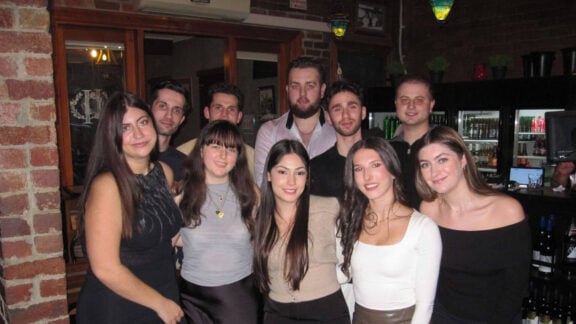A chance meeting between two Greek Australian professors spawned not only a breakthrough in the way autism is diagnosed but a realisation that two brains are better than one. Professor Stan Skafidas and Professor Christos Pantelis have combined their knowledge to enable them to uncover new discoveries that required novel ways to look at the problem. By joining Professor Skafidas’ understanding of neural engineering with Professor Pantelis’ psychiatric expertise, these medical minds – along with their teams – have the capacity to unlock many secrets of the brain.
“I think the coming together of expertise from two centres with different areas of expertise is a fabulous way forward,” explains Professor Pantelis.
As it stands, medical research is usually conducted in a vacuum of independent discipline. Both professors champion this new style of research.
“Working together in this way hasn’t happened very much until now, but I think it has to be the way forward if we are going to understand a complex structure like the brain. When expertise from many disciplines comes together in this way, we can see the problem in new ways and this can lead to new findings,” said Professor Skafidas.
“By working together, they have identified an early genetic test to predict a child’s risk of autism. This is the first known blood test of its kind to indicate whether or not a child is likely to develop autism. This way, doctors can detect those at increased risk for autism and potentially start treatments earlier. But the professors are keen to point out that the test is not diagnostic; rather, it gives clinicians an index of level of risk for autism and therefore has to be used in conjunction with traditional diagnostic measures. The test came about organically as the professors were focused on first understanding the genetic causes of autism.
“We know that autism can affect a number of members of one family. We also know that in identical twins there is a very high likelihood that both will have the disorder if one is affected. This tells us that genes are important, but we also know that one gene isn’t enough to cause autism.”
The professors decided to embark on a study to examine how lots of genes came together to cause autism spectrum disorder (ASD). Together, they examined the genes of over 8,000 people, including those with ASD, their relatives and others not affected, to see if they could correctly identify who had the disorder based on their genetics. And they succeeded.
“Most people have been looking at these disorders with the idea to find the ‘magic’ gene that explains this disorder but what’s unique with what we’ve been doing is saying well we know that these groups of genes are important for a particular function and let’s test them as a group in order to try and understand which functions are actually potentially contributing to the disorder,” Professor Skafidas told Neos Kosmos.
Using data from 2,599 individuals with ASD and 2,587 of their relatives from Autism Genetic Resource Exchange (AGRE) and Simons Foundation Autism Research Initiative (SFARI) as well as 2,930 unaffected individuals from the Wellcome Trust Birth Cohort, the researchers identified 237 genetic markers (SNPs) in 146 genes and related cellular pathways that either contribute to or protect an individual from developing ASD. The discovery of the combination of contributing and protective gene markers and their interaction helped to develop a very promising predictive ASD test as the test is based on measuring both the risk and protective genetic markers of ASD. As the risk markers increase the score on the genetic test also increased, while the protective markers decrease the score, therefore, the higher the overall score the higher the risk of ASD.
“[The test] gives us a measure of the level of risk, and that I think will be helpful to clinicians when they are assessing young people,” Professor Pantelis points out while emphasizing that this test assesses the risk for ASD and it is not a diagnostic test.
The exciting aspect for the professors is the ability to link the two disciplines to uncover more research and breakthroughs such as this genetic test for autism. In the future, the professors want to do what they have done for autism for other mental disorders such as schizophrenia, bipolar disorder, attention deficit disorder, depression, and more. Professor Pantelis wants to start with looking at the area of schizophrenia, as it also has a high genetic component like autism.
Schizophrenia is an area that interests Professor Pantelis and his team. As the Scientific Director of the Melbourne Neuropsychiatry Centre, he leads a team of researchers that have been undertaking neuroimaging and neuropsychological work in schizophrenia and psychosis, and other psychiatric and neurodegenerative disorders since 1993 after returning from 10 years working in London and Washington DC. His work has focused on brain structural and functional changes during the transition to psychosis. His group was the first to describe progressive brain structural changes at psychosis onset.
As the Director for Centre for Neural Engineering, Professor Skafidas has led NICTA’s research into the development of next-generation retinal stimulation prostheses – put simply, the bionic eye. Just about to start human trials, Professor Skafidas has been part of a team researching the possibility of combining wireless technology and ophthalmics to overcome macular degeneration, the single biggest cause of blindness in the developed world.
Together, these two Greek Australian professors are leading the way in neural research and paving the way forward to show that in medical research two brains are well and truly better than one.
“That’s a really important piece in the puzzle,” says Professor Pantelis. “What we want to do is try and supervise and nurture young people in this space between the disciplines were they can learn both psychiatric research, biological research and engineering research and bring the two together and understand the language of both to try and create something which we couldn’t do otherwise.”
Advertisement









